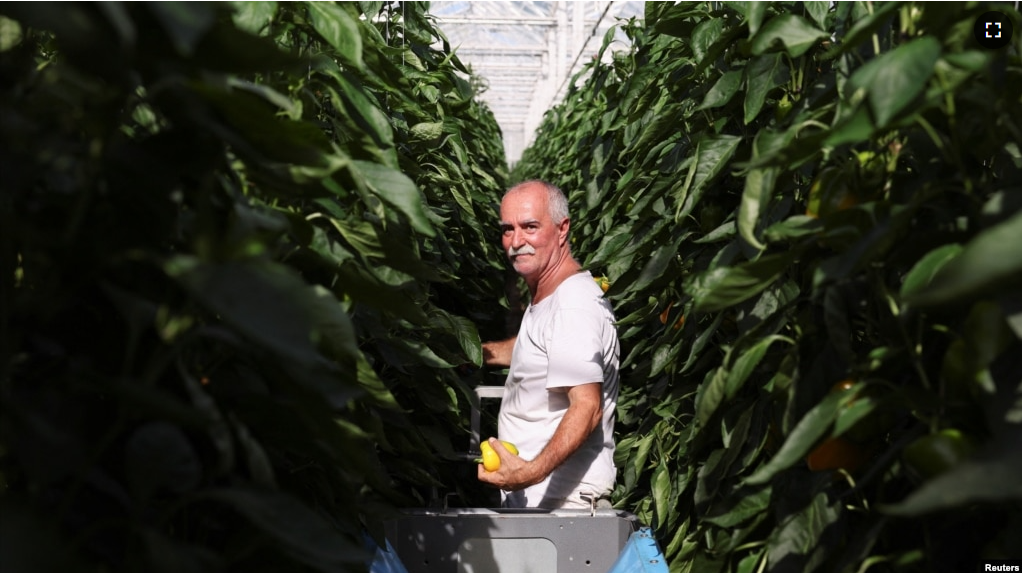Greenhouses – buildings that are used for growing plants – have helped make the Netherlands the world’s second largest agricultural exporter after the United States.
But the $7.9 billion industry developed when gas was less costly. A price crisis will likely speed up a change to other energy sources, but it could also cause many businesses to fail.
Price increase
European gas prices have increased by about 20 times the level they were at a year ago. The increase is mainly a result of Russia restricting gas supplies in answer to Western sanctions over its invasion of Ukraine.
Industry group Glastuinbouw Nederland says up to 40 percent of its 3,000 members are having financial problems. That could result in less out-of-season fruit, vegetables and flowers in European stores. It could also mean production might move to warmer countries such as Spain, Morocco and Kenya.
Greenhouse owner Pieter Wijnen would like to pay attention to growing vegetables. But his life has centered on gas and electricity prices rather than his vegetables – bell peppers and cucumbers.
“In a greenhouse like this in the wintertime, you need to heat it,” he said of his 32 hectare property in the southern Dutch area of Limburg.
Wijnen added, “When prices are going up, and it will be much more than we are used to, then we must change our plans.”
Among other measures, Wijnen is cutting the area he will keep warm at Wijnen Square Crops this winter. He plans to grow fewer, larger cucumbers – as well as selling additional electricity that he generates.
Until recently, Dutch greenhouses used around three billion cubic meters of gas a year, or about eight percent of the national total. That number has been falling as renewable choices become available.
According to Statistics Netherlands, the industry’s gas usage fell 23 percent in the year through June.
But the amount of decrease this year is as much a sign of difficulty as it is of change, growers say.
Michel van Schie of Royal HollandFlora said, “A large number of growers are choosing to close down their business because they don’t expect any change in the short term.”
Stores have cut orders for flowers by around a third, expecting people to spend less as living costs increase, he added.
History and future
The Dutch greenhouse industry has a deep connection with natural gas due to the Groningen gas field, which was Europe’s largest for many years. Production was cut back in the 2010s due to the earthquakes it caused.
Some larger greenhouses like Wijnen’s have plants that burn gas to create both heat and electricity – a system with 2.4 gigawatts of capacity spread nationwide, about 14 percent of the Dutch total.
Many greenhouses need heat more than electricity, and can sell additional power during highest demand.
Some greenhouses have invested in biomass for warmth, though wood is becoming less available and more costly. A few have geothermal heating. All make use of solar power for warming and plant growth – the original greenhouse effect.

“Each and every grower is unique, which makes it very hard to draw conclusions about this crisis,” said Cindy van Rijswick of Rabobank, a financial services company. Van Rijswick added that some Dutch greenhouses with lower cost gas contracts may do well.
As Groningen production went down, Wijnen invested 30 million euros in a geothermal project and biomass factories. But his gas plants that produce both heat and electricity are currently helpful.
“I do not need all the electricity, but the market needs the expensive electricity, so we make electricity, sell it to the grid, and then the heat is sometimes quite cheap for me,” he said.
Still, Rabobank’s Van Rijswick said the current crisis was likely to change the industry, with the move towards local production possibly reversing.
“It’s like we will go back in history again with Spain producing in wintertime and the northern European countries producing their own vegetables in summertime. Some people say maybe that’s the way it should be.”
I’m John Russell.
Toby Sterling reported on this story for Reuters. John Russell adapted it for VOA Learning English.
__________________________________________________________________
Words in This Story
grid – n. a network of electrical wires and equipment that supplies electricity to a large area
capacity – n. the amount of something that can be produced or managed by a factory, company, etc.
geothermal – adj. of, relating to, or using the natural heat produced inside the Earth
biomass – n. plant materials and animal waste used especially as a source of fuel
